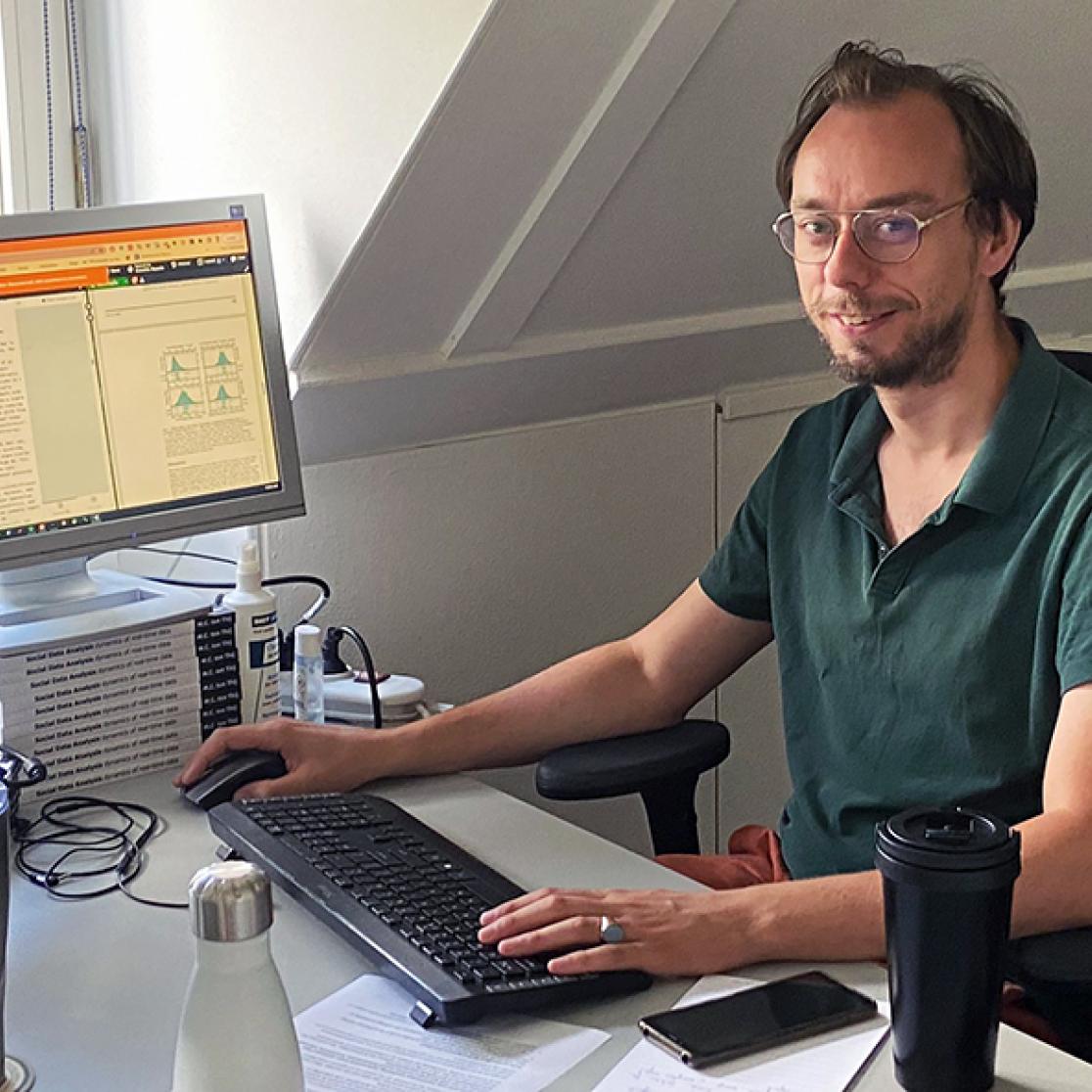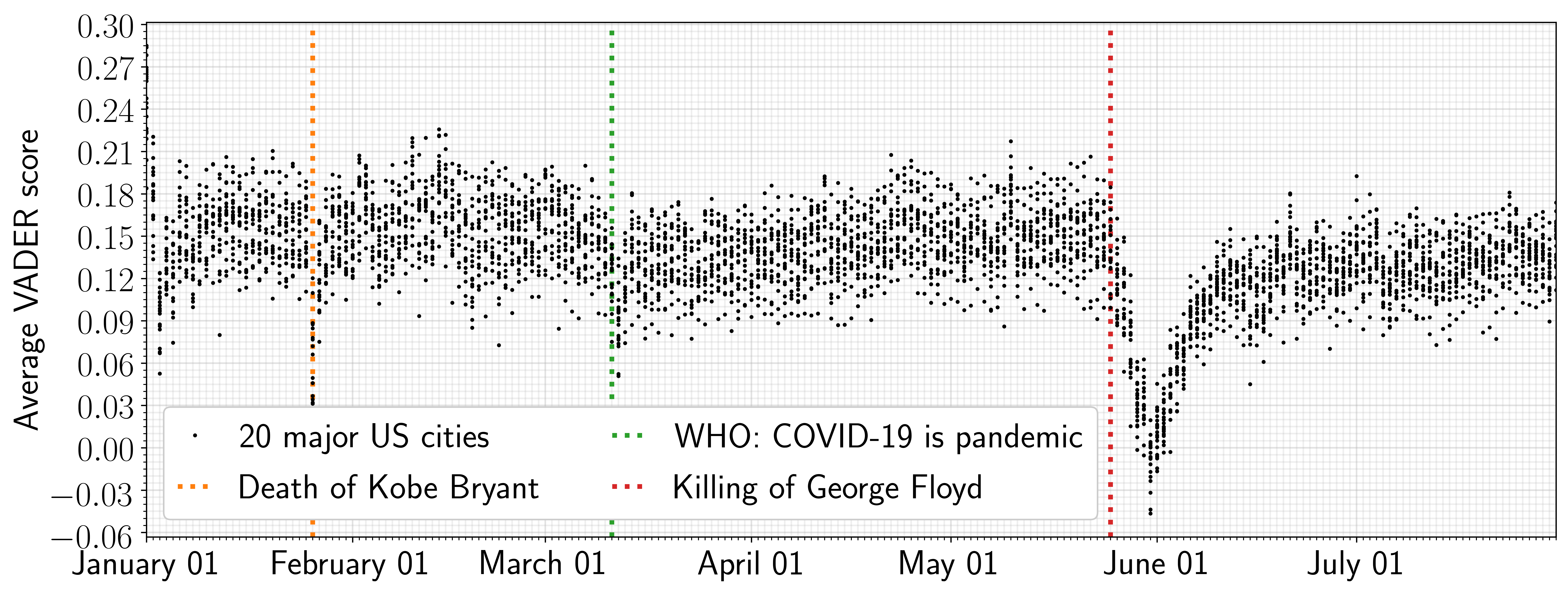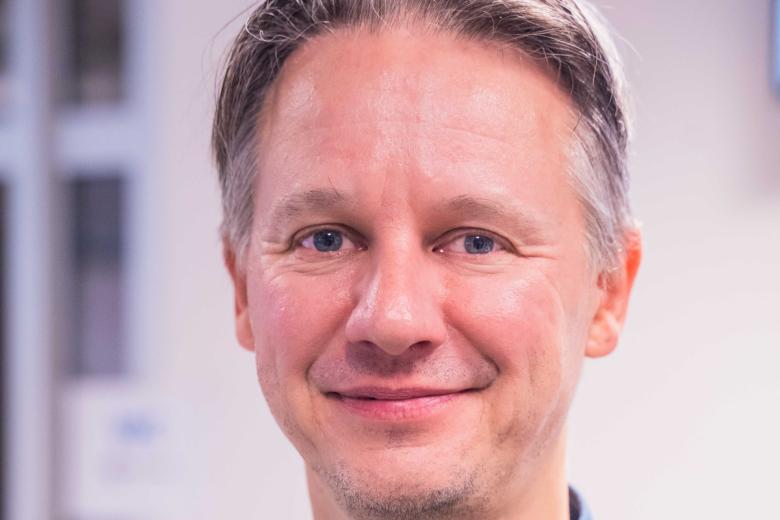Show me your Twitter feed and I'll tell you what your problem is
Data scientist Marijn ten Thij studies human behaviour on the basis of messages posted on social media. For example, he mapped the changing mood during the corona pandemic using 3.5 million tweets. The analysis of this kind of data is not only socially relevant, it could also help individuals in psychological distress. The underlying patterns are quite intriguing, says Ten Thij.
“My field is data analysis, my background is applied mathematics and in recent years I have moved more and more towards computer science.” This is how Marijn ten Thij, assistant professor in the Department of Advanced Computing Sciences, summarises his working life. His focus is on studying human behaviour by analysing the traces that many of us leave behind every day - on online platforms and networks. “My research shows that you can learn a lot about people and society based on the information we voluntarily disclose, without compromising the privacy of individual users.”
Project X
More or less by accident, Marijn discovered Twitter as a suitable data source. As part of his studies at the University of Twente, he became interested in modelling the distribution of information in an online network. It was around this time when a small town in the Dutch province of Groningen, Haren, suddenly became world news. In 2012, a girl invited her friends to her birthday party via Facebook; however, thousands of people came. The town was not prepared for such an invasion, the mood quickly changed and Project X Haren ended in riots and vandalism.
“At the time, I looked into the question of whether it could have been predicted that the party would get out of hand. Could we use mathematics for that? Later, I started looking for a way to find the right people on Twitter to perform a specific analysis or measure a specific effect; and how we can do that without tracing the results back to individual accounts. That, in a nutshell, is what my work consists of.”
Measuring sentiment
This has led to a large number of studies on various societal topics. Almost every month this year, a research paper of his has appeared in international publications. For example, he used mathematical models to describe the psychosocial factors underlying rigid positions on both sides of the abortion debate and measured the socio-emotional impact of natural disasters such as hurricanes.
Earlier Ten Thij showed, based on millions of tweets, how the COVID pandemic led to a change in the way people thought about the future. One of the results was that tweets about the medium-term future showed more gloom than tweets referring to the near or far future. Sentiment was lowest for the period between four weeks and 12 months from when the tweet was posted. Interestingly, this revealed underlying patterns that were also found for entirely different themes.
Recurring wave pattern
During the first major COVID wave, Ten Thij, as a member of an international research group, studied the average daily sentiment in 20 major cities in the US. They used machine learning and open-source algorithms such as VADER. It was also a period in which several radical events took place.
“But whether it was the death of basketball player Kobe Bryant, the moment when COVID-19 was officially declared a pandemic, or the murder of George Floyd, each time you see a kind of wave pattern in social sentiment. First, there is a clear exponential drop in sentiment, after which it steadily returns to its former level. In another study, we actually discovered the same patterns with hurricanes. So, you see how news cycles become interwoven in a platform like Twitter and how our attention is first grabbed and then lost. Intriguing because it seems as if the underlying issue doesn't really matter, and that there are very simple formulas behind our behaviour.”

Marijn ten Thij is assistant professor in Data Fusion at the UM Department of Advanced Computing Sciences. After graduating in applied mathematics from the University of Twente, he performed research at various universities including Vrije Universiteit Amsterdam, Technische Universiteit Delft and Indiana University.
Ten Thij’s research seeks to explain human behaviour by analysing the traces we leave in on-line platforms and networks. In recent years, he has authored and co-authored several data-driven publications on cognitive topics and mental health issues.

Added value in psychotherapy
The same mathematical models can also be applied to individual cases. Ten Thij recently started a line of research that examines how data from social media can be used in therapy; for example, in the treatment of depression - only when the patient gives explicit permission.
“It can provide added value. Of course, we are not going to fully automate psychiatry with our algorithms, because as soon as you start working with people, you always have to consider individual details and differences. However, if you start from the theory of cognitive behavioural therapy, one of the most used methods to treat depression, then you can check individual timelines for thought patterns that are associated with depression. We can then provide tools to understand and interrupt those thought patterns so that a person no longer has them.”
This can help make sessions with a psychologist more effective. “The time with a psychologist can then be used differently. Your disturbed thought patterns would have already been detected on your social media posts and you would have received feedback on them before you meet with your therapist.”
Ten Thij emphasises that there are countless other modalities on which you could unleash his mathematical models. Your personal WhatsApp history, for example. “That is also what we want to establish in this particular study: what is the best data source to help psychologists in the best possible way?”
Self-analysis
Should this become reality, Ten Thij's own timeline would not seem to qualify for this kind of analysis. “No, I am not the type who posts a lot and shares his innermost thoughts and feelings. This is evident from the fact that my wife and I only became Facebook official after five years into our relationship. I do have many social media accounts, but mainly for professional reasons. I need to be able to keep an eye on them for possible use as a data source.”
Does that mean he can't unleash his models on his own Twitter feed and find out a bit more about himself? “Yes, that's true, because I don't provide myself with enough data.”
Facebook may have ten times as many users, but Twitter is a more suitable data source for researchers like Ten Thij. This is mainly due to the high accessibility of the platform.
In addition, research at Stanford by Johannes Eichstaedt shows that there is a high correlation between sentiment on Twitter and sentiment expressed in questionnaires and opinion polls in the US.
Ten Thij: “As a researcher, you always try to determine whether the platform you are using is representative. You have to keep checking because platforms evolve and people use them differently.”
Lees ook
-
Betere kwaliteit van leven binnen de ouderenzorg
Hilde Verbeek (CAPHRI) geeft onderwijs en ontwikkelt nieuwe woonvormen als alternatief voor verpleeghuiszorg.

-
Oratie Jan Willem van Prooijen
Wat drijft mensen ertoe om radicale complottheorieën te omarmen, met soms verregaande gevolgen voor de samenleving? Tijdens zijn oratie op vrijdag 27 juni gaat prof. dr. Jan Willem van Prooijen (radicalisering, extremisme, en complotdenken) in op deze urgente vraag.

-
Update 25 juni
Afgelopen nacht is een UM-gebouw aan de Bouillonstraat met verf en enkele leuzen beklad. Een trieste uiting van vandalisme. De UM heeft aangifte gedaan.
